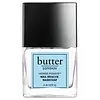What's inside
What's inside
 Key Ingredients
Key Ingredients

 Benefits
Benefits

 Concerns
Concerns

 Ingredients Side-by-side
Ingredients Side-by-side

Ethyl Acetate
PerfumingButyl Acetate
MaskingAlcohol Denat.
AntimicrobialNitrocellulose
Adipic Acid/Neopentyl Glycol/Trimellitic Anhydride Copolymer
Isopropyl Alcohol
SolventTrimethylpentanediyl Dibenzoate
Acetyl Tributyl Citrate
MaskingSucrose Acetate Isobutyrate
Etocrylene
UV AbsorberRetinyl Palmitate
Skin ConditioningTocopheryl Acetate
AntioxidantDimethicone
EmollientBiotin
AntiseborrhoeicCalcium Pantothenate
Glycerin
HumectantEquisetum Hyemale Extract
Skin ConditioningGlycidoxypropyl Trimethoxysilane
Methacryloyl Propyltrimethoxysilane
Methyltriethoxysilane
Mercaptopropyltrimethoxysilane
Ascorbic Acid
AntioxidantCI 60725
Cosmetic ColorantEthyl Acetate, Butyl Acetate, Alcohol Denat., Nitrocellulose, Adipic Acid/Neopentyl Glycol/Trimellitic Anhydride Copolymer, Isopropyl Alcohol, Trimethylpentanediyl Dibenzoate, Acetyl Tributyl Citrate, Sucrose Acetate Isobutyrate, Etocrylene, Retinyl Palmitate, Tocopheryl Acetate, Dimethicone, Biotin, Calcium Pantothenate, Glycerin, Equisetum Hyemale Extract, Glycidoxypropyl Trimethoxysilane, Methacryloyl Propyltrimethoxysilane, Methyltriethoxysilane, Mercaptopropyltrimethoxysilane, Ascorbic Acid, CI 60725
Ethyl Acetate
PerfumingButyl Acetate
MaskingNitrocellulose
Adipic Acid/Neopentyl Glycol/Trimellitic Anhydride Copolymer
Acetyl Tributyl Citrate
MaskingIsopropyl PCA
HumectantSucrose Acetate Isobutyrate
Hea Ipdi Isocyanurate Trimer/Polycaprolactone Diol Copolymer
Glycolic Acid
BufferingTris-Hea Ipdi Isocyanurate Trimer
N-Butyl Alcohol
PerfumingEtocrylene
UV AbsorberWater
Skin ConditioningTrimethylpentanediyl Dibenzoate
Malic Acid
BufferingHexanal
MaskingLactic Acid
BufferingPanthenol
Skin ConditioningMagnesium Ascorbyl Phosphate
AntioxidantChamomilla Recutita Flower Extract
MaskingCalcium Pantothenate
Ferrous Gluconate
Skin ConditioningOenothera Biennis Oil
EmollientTocopheryl Acetate
AntioxidantPolyvinyl Butyral
Cucumis Sativus Fruit Extract
EmollientRapeseed Glycerides
EmollientAlcohol Denat.
AntimicrobialCarthamus Tinctorius Seed Oil
MaskingCI 60725
Cosmetic ColorantAllium Sativum Bulb Extract
Skin ConditioningBiotin
AntiseborrhoeicEthyl Acetate, Butyl Acetate, Nitrocellulose, Adipic Acid/Neopentyl Glycol/Trimellitic Anhydride Copolymer, Acetyl Tributyl Citrate, Isopropyl PCA, Sucrose Acetate Isobutyrate, Hea Ipdi Isocyanurate Trimer/Polycaprolactone Diol Copolymer, Glycolic Acid, Tris-Hea Ipdi Isocyanurate Trimer, N-Butyl Alcohol, Etocrylene, Water, Trimethylpentanediyl Dibenzoate, Malic Acid, Hexanal, Lactic Acid, Panthenol, Magnesium Ascorbyl Phosphate, Chamomilla Recutita Flower Extract, Calcium Pantothenate, Ferrous Gluconate, Oenothera Biennis Oil, Tocopheryl Acetate, Polyvinyl Butyral, Cucumis Sativus Fruit Extract, Rapeseed Glycerides, Alcohol Denat., Carthamus Tinctorius Seed Oil, CI 60725, Allium Sativum Bulb Extract, Biotin
Ingredients Explained
These ingredients are found in both products.
Ingredients higher up in an ingredient list are typically present in a larger amount.
Acetyl Tributyl Citrate is a fragrance.
We don't have a description for Adipic Acid/Neopentyl Glycol/Trimellitic Anhydride Copolymer yet.
Alcohol Denat. is an alcohol with a denaturant property. It is created by mixing ethanol with other additives.
This ingredient gets a bad rep because it is irritating and drying - mostly due to its astringent property. Astringents draw out natural oils in tissue, constricting pores and leaving your skin dried out.
However, alcohol denat. is not all that bad.
Due to its low molecular weight, alcohol denat. tends to evaporate quickly. One study on pig skin found half of applied alcohol evaporated in 10 seconds and less than 3% stayed on skin.
This also helps other ingredients become better absorbed upon application.
Studies are conflicted about whether this ingredient causes skin dehydration. One study from 2005 found adding emollients to propanol-based sanitizer decreased skin dryness and irritation. Another study found irritation only occurs if your skin is already damaged.
Small amounts of alcohol are generally tolerated by oily skin or people who live in humid environments.
The rule of thumb is if this alcohol is near the end of an ingredients list, it will probably not affect your skin much.
Also...
This ingredient has antimicrobial and solvent properties.
The antimicrobial property helps preserve products and increase their shelf life. As a solvent, it helps dissolve other ingredients.
Other types of astringent alcohols include:
Learn more about Alcohol Denat.Biotin is a B vitamin that is naturally produced by our bodies. It is also called Vitamin H.
Our bodies use biotin in the metabolism process. It also helps our bodies use enzymes and move nutrients around. A biotin deficiency can lead to brittle hair and nails.
More research is needed on applying biotin topically. However, taking biotin orally has been shown to help nourish the skin, hair, and nails. They play a role in forming skin-hydrating fatty acids.
Biotin is water-soluble. It can be found in foods such as fish, eggs, dairy, nuts, and meat. Vitamin H stands for "haar" and "haut". These are the German words for hair and skin.
Learn more about BiotinWe don't have a description for Butyl Acetate yet.
Calcium Pantothenate is calcium salt from Vitamin B5. It can be naturally found in plants and animals.
Calcium Pantothenate is a potent antioxidant. Antioxidants help fight free-radical molecules. Free-radical molecules are capable of damaging our cells and other genetic material. Antioxidants help stabilize free-radicals by donating extra electrons. This may help reduce the signs of aging.
Our bodies use Calcium Pantothenate for various metabolic functinos. These functions include metabolizing carbohydrates, proteins, and fatty acids.
Learn more about Calcium PantothenateThis synthetic colorant is used to add a violet color to products. It is water-soluble.
Ethyl Acetate is a fragrance.
We don't have a description for Etocrylene yet.
We don't have a description for Nitrocellulose yet.
We don't have a description for Sucrose Acetate Isobutyrate yet.
Tocopheryl Acetate is AKA Vitamin E. It is an antioxidant and protects your skin from free radicals. Free radicals damage the skin by breaking down collagen.
One study found using Tocopheryl Acetate with Vitamin C decreased the number of sunburned cells.
Tocopheryl Acetate is commonly found in both skincare and dietary supplements.
Learn more about Tocopheryl AcetateWe don't have a description for Trimethylpentanediyl Dibenzoate yet.